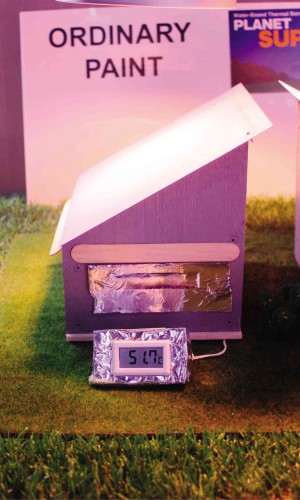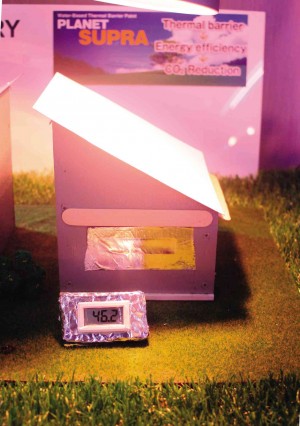A new line of paints based on infrared reflective tech

A COMPARISON of two “roofs,” one coated with ordinary paint and another with a nano thermal barrier paint, shows the difference in temperature.
Choosing the paint for the roof over your head could save your household energy—and even the environment.
According to Pacific Paint (Boysen) Philippines Inc. vice president Johnson Ongking, the idea of using the roof as a reflector for households to keep away the heat has been around for a long time, notably with white roofs in the Greek islands. While the ancient Greeks may have figured out that white is the best color for reflecting light and heat, it is now also known that that color gives an extra benefit on energy savings.
“Through what’s known as the ‘albedo effect,’ white roofs reflect sunlight back into space, so there is less heat that can be trapped by greenhouse gases in the first place,” he said.
However, most Filipinos prefer roofs of various colors.
“From roofs painted white will reflect sunlight and keep homes cooler while dark-painted roofs absorb sunlight which turns to heat and make homes warmer,” he said.
Article continues after this advertisementA challenge
Article continues after this advertisementBy this, Ongking believes that for Boysen, as a paint manufacturer, it was a challenge to find a way to make roof paints in the colors that people seem to prefer but somehow make them more reflective. That is why in 2013, Boysen introduced a new line of paints based on infrared reflective technology called “Cool Shades.”
Ongking explained that while the infrared light may be invisible and has no effect on the color, it is what we feel as heat. If the infrared light reflection of a paint color could be improved, the Total Solar Reflectance (TSR), or the ability of a colored object to reflect infrared light, would increase and dark-colored paints would be more reflective.
For instance, Ongking said the zen brown color in Cool Shades is exactly the same color as the chocolate brown from a standard roof coating line, but its TSR is four times better.
“To put this in context, in tests we’ve done so far it could result in lowering indoor temperatures by 1°C to 4°C, which means less work for the air-conditioner and more energy savings,” he said.

A COMPARISON of two “roofs,” one coated with ordinary paint and another with a nano thermal barrier paint, shows the difference in temperature.
Ongking noted that while standard paints with light colors are naturally more reflective, they may lose their reflective property as the paint gets darker due to exposure to dirt and pollution. Boysen, therefore, made Cool Shades dirt-resistant for it to stay clean and reflective over time.
Cool Shades also comes in other colors such as shady gray, radiant beige, polarize blue, spring green and vibrant terra cotta.
“The concept is still new so it will take some time to be adopted, but it is our hope that over time all Filipinos will have ‘rooflectors’ over their heads to help save money, energy and our planet,” Ongking said.
According to him, heat-reflective paints are a positive investment not only for the household budget, but also for the society and the environment. By lessening the heat coming from the roof, homes and other structures will use less air-conditioning, which is usually the biggest component of the energy bill.
“Lower energy use does not only mean immediate savings from energy bills, but also a smaller carbon footprint. If adopted by a large part of our population, significant decrease in energy usage would lead to fewer power plants needed, which would help our current power shortage situation,” he said.
Energy-efficient solutions
A similar technology from Japan was launched last month during the Build Eco Xpo Asia 2014 in Singapore.
Enovatek Energy, a Thailand-based company that provides energy-efficient solutions to industries and businesses, introduced its line of heat-reflective paints innovated in Japan called “Planet Supra Nano Thermal Barrier Paints.”
Aman Bajaj, executive director of Enovatek Energy claimed it is the most energy-efficient paint in the market as it reflects about 94.6 percent of sunlight away from the roof.
“There’s a report made by the Japanese government saying that for every one-degree point reduction of temperature under the roof will result about 3-percent savings in air-conditioning,” he said.
Planet Supra uses ultrafine hollow nano silica beads which reflects the solar radiation. Planet Supra releases the 95 percent of the heat out of the building. Only the remaining 5 percent comes in.
Benefits
“Most paints in the market are ceramic-roof paints, which reflect 80-85 percent of the heat. In terms of savings with our 95 percent… this is actually 50 percent better,” said Rajesh Sivasriaumphai, Enovatek operations director.
He added that Planet Supra may be 10 to 15 percent more expensive than normal paints, but it would guarantee up to 10 years of no peeling and scratching of roofs.
“Another benefit you have from this is that when it rains, the dirt and the dust would just run off. Ceramic paints have spots of water while this one, everything just slides right off,” Sivasriaumphai said.
Like Boysen Cool Shades, Planet Supra offers a wide variety of colors in matte and glossy finish.
In addition to Planet Supra, Enovatek is working on another line of paints called iBright. Launched in February in Japan, iBright is a highly-reflective paint for lights inside the building, causing 40-percent brightness than normal. It is the first of its kind.